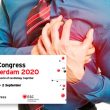Potent P2Y12 receptor inhibitors, such as prasugrel and ticagrelor, have been tested mainly in a setting of acute coronary syndromes. There is little evidence on stable patients, particularly for prasugrel. Designing a study with that purpose seemed challenging enough, but adding aspirin discontinuation in patients without a particularly high bleeding risk took this research to...
The Ten Commandments from the New Guidelines on Infarction Without ST-Segment Elevation
In 2020, the European Society of Cardiology guidelines for the management of patients with acute coronary syndromes without ST-segment elevation (Non-ST-Segment Elevation Myocardial Infarction, NSTEMI) were presented. This document went somewhat unnoticed in the context of the COVID-19 pandemic, so this seems a good time to review it and set out some practical “commandments” (something...
TCT 2020 | Ticagrelor Monotherapy After ST-Segment Elevation Infarction
Ticagrelor monotherapy after 3 months of dual antiplatelet therapy in patients who experienced ST-segment elevation infarction significantly reduces major bleeding without increasing ischemic risk. This pre-specified analysis of the TICO study shows that ticagrelor monotherapy is safe even in patients with higher ischemic risk. Interrupting aspirin use after 3 months of dual antiplatelet therapy and continuing treatment...
How To De-Escalate Prasugrel After Acute Coronary Syndrome?
Patients who undergo coronary angioplasty after acute coronary syndrome could de-escalate dual antiplatelet therapy with prasugrel to maintain the protection against ischemic events while lowering their hemorrhagic risk. The HOST-REDUCE-POLYTECH-ACS study (recently published in The Lancet) included 2338 patients who underwent coronary angioplasty in a setting of acute coronary syndrome. Patients were randomized to a year-long...
Complex PCI: Complex Characteristics Impact Results
Patients with a bigger number of complex anatomical characteristics that increase PCI complexity have worse results at one-year followup. These data come from a large multicenter study (e-Ultimaster) recently published in EuroIntervention. The more complex the characteristics, the greater the increase in events. It is important to see past the obvious anatomical challenges (bifurcations, calcification,...
Post TAVR ASA Monotherapy Consolidates
This meta-analysis to be published in J Am Cardiol supports the use of aspirin monotherapy (ASA) after transcatheter aortic valve replacement (TAVR). The use of aspirin alone is associated to less bleeding without increased ischemic events such as strokes or mortality. The combined outcomes of four studies, including the recently published POPular TAVI (cohort A),...
Evidence or Theory? Antiaggregation Scheme after Peripheral Vascular Intervention
Antiaggregation indication after peripheral intervention (PVI) can vary up to 50% depending on center, operator, and procedure. This highlights the huge variation in indication and the scarce evidence there is on this matter. Most cardiologists would like to simply transfer the information from the coronaries to the superficial femoral, but we can confirm this does...
ESC 2020 | New European Guidelines on Non-ST-Segment Elevation Acute Coronary Syndromes: What’s New?
The new European guidelines on NON-ST-segment elevation acute coronary syndromes (NSTE ACS) were presented virtually during the European Society of Cardiology 2020 Congress (ESC 2020) and published in Eur Heart J. This document includes news regarding a more agile infarction diagnosis, the use of non-invasive imaging, the simplification of anticoagulant therapy, infarction with normal coronary arteries,...
Can Aspirin Use Be Interrupted After Angioplasty?
Aspirin discontinuation 1 to 3 months after angioplasty with continued P2Y12 inhibitor therapy reduces the bleeding risk without an increase in thrombotic events. This is also the case for patients admitted with acute coronary syndrome. Dual antiplatelet therapy with aspirin and a P2Y12 inhibitor has been shown to reduce the risk of major events compared with...
Is Medical Treatment Better at Lowering Bleeding-Caused Mortality than Angioplasty?
Post-discharge bleeding in patients admitted for acute coronary syndrome (ACS) is linked to higher all-cause mortality. However, this is the case for both patients who underwent angioplasty and those who were managed with medical treatment. These are interesting data, given that medical treatment is frequently preferred due to lower bleeding risk. Speculation is based on...








